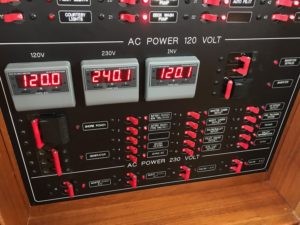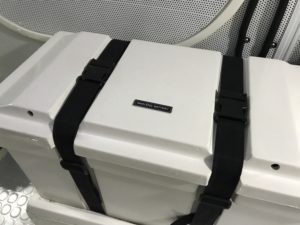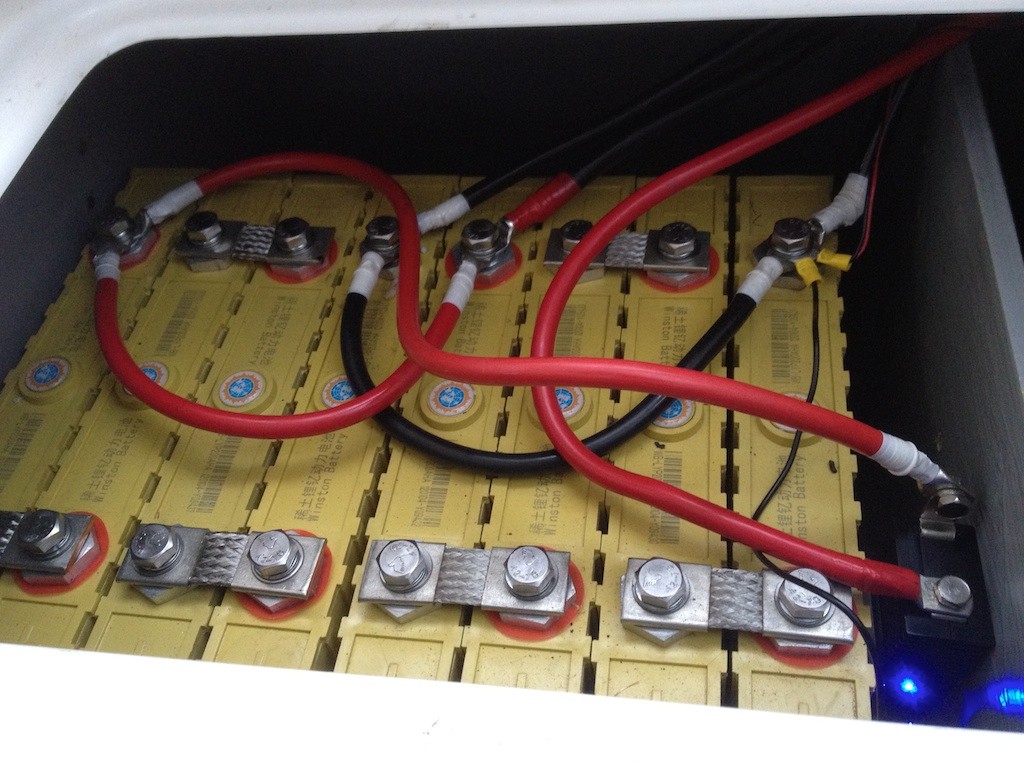The house battery bank
We have designed and built more than 400 vessels since 1999 and we keep a constant watch on new technologies, “greener” equipment and anything that can improve safety and comfort at sea on our yachts. But we also like to know what our customers think, like or dislike. One of our clients who has owned several power yachts and who currently owns a new Selene has shared his experience with us… It’s worth reading his comments about the “house bank”.
What battery bank on a long range power yacht?
Just like the debate over twin or single engines on a passage-maker, or the raging battle about fibreglass vs steel, the question of gel vs lithium-ion batteries also has the potential to ignite World War III whether on online forums or at the pub… Armchair sailors and engineers alike love to talk about the mutual benefits of each battery solution. Not to mention that lithium-ion batteries are becoming trendy in the boating industry. The li-Ion chemistry is called lithium ferrous phosphate, LiFePO4 or LFP for short, but it’s a long story when it comes to installing them on yachts… And it’s not a mere box-dropping exercise.
Without going as far as doing the maths with amps, watts and charging parameters, what is, in the owner’s point of view, important to take into account when selecting a house bank for a new boat? Let’s try to remain simple and practical.
The simple facts on a trawler…
LFP batteries, if we keep aside the, not so important, fact they are more expensive, also happen to be smaller and lighter than any other batteries, and can be charged faster than gel or AGM batteries. But unless the boat is a sailboat or a catamaran chasing undesired weight, what’s the point of saving space and weight on a 20 or 70-ton yacht? And what’s the point of charging faster when in most cases, the generator will be running all night long for zero-speed fins or gyro stabilizer, air conditioning or heating at anchor, or any other electricity-dependent commodity? Reducing the charging time while at anchor or underway on a sailboat, which has no other power source than its main engine makes sense. But does it make sense on a passage maker crossing oceans under power or with a high power draw requiring almost constant operation of a genset? Many comments and posts on the forums will explain that one can deplete lithium-ion batteries completely without killing them, whereas one may not go below 50% with gel batteries. So what? A power boat is not a sailboat drawing power for the autopilot and radar under sail while depleting the batteries… When a power yachts is underway, it charges its batteries at the same time with the alternator! In other words, there is always plenty of current to charge the house bank and at anchor the genset takes over, not to mention the fact that underloading a generator can damage it…

The simple solution on a trawler…
After all, it makes little sense to design the specifications of a power yacht as if it was a light catamaran or racing sailboat. And taking into account the “life expectancy” of batteries in general, including lithium-ion, good old gel batteries will probably be the best option in all cases. Gel is the cheapest, and the most reliable, simple solution for a house bank. Especially taking into account that most marine batteries chargers “know” how to handle the “bulk-absorbtion-float” cycle, but cannot charge properly lithium-ion batteries unless the batteries are equipped with a dedicated BMS (battery management system), whether it’s built in the batteries like some expensive cells designed in the Netherlands, or if it’s a standalone unit installed and calibrated properly. LFP batteries are not lead acid batteries and they are not designed nor intended to be “float charged“. As a conclusion, what is the purpose of a BMS? It will prevent overcharging, which is fatal to lithium-ion batteries. It’s as simple as that. Competent engineers have concluded that LFP batteries are not just batteries; they must be treated as a “system.” And they are right. Do we really want another new high tech “system” on our boat while good old chargers and batteries will give us years of happy and trouble-free operations?

Complexity and price
Some very interesting posts written by engineers on the Internet are very clear about it; LFP batteries can be “quickly compromised, and have their capacity diminished, or even destroyed, if over-charged.” Lithium ion batteries without a BMS will not last and could be dead six months after installation. It is as simple as that. Is it worth to save one or two hundred kilos on a displacement vessel? Probably not, unless the owner is a competent electrician or a technology geek. Is it worthwhile to install rocket science technology initially designed for streetlights or GSM antennas on a boat? Probably not if the boat is bound for remote destinations where a faulty BMS will be impossible to replace while gel batteries will be available on any street corner, even in New Guinea Papuasia or Patagonia…
What is the conclusion? As a live aboard captain with a couple of miles and ocean passages on my logbook, I would always prefer a system that I understand and master with a multimeter and a screwdriver… I am not an electrician or an engineer, and I am not planning to become one. I like to enjoy sailing, cook at anchor, entertain my friends and family, and I don’t want to spend my time fixing and fine-tuning systems or end-up with a dashboard looking like an Airbus cockpit… Some owners like messing with their yacht at pontoon for months and very seldom go to sea. This is not my vision.

The KISS philosophy, “Keep It Stupid Simple…”
Selecting a LFP house bank is only an option, and it may become easier, or even a standard feature in the future like hybrid propulsion, but there are still constraints; mainly in the form of the complexity of a standalone BMS or the high price tag of a fully integrated system. And for what benefit? Less weight and faster charging… Both are useless in most cases. And the replacement of a gel batteries bank will only cost a fraction of the price of a LFP bank after five or six years… Why bother? A yacht must remain a dream machine, not a technology exhibition or workbench…

